
Our Potable Aqua Water Purification Tablets make questionable water bacteriologically suitable to drink. Easy to use-water is ready in 30 minutes. One 50 tablet bottle treats 25 quarts of water. Ideal for hiking, backpacking and travel. Perfect addition to your first aid or travel kit.Used worldwide by campers, hikers, militaries, emergency organizations, and anyone else who needs to drink water of questionable quality, these Portable Aqua iodine tablets will disinfect contaminated drinking wate
Potable Aqua Water Treatment Tablets
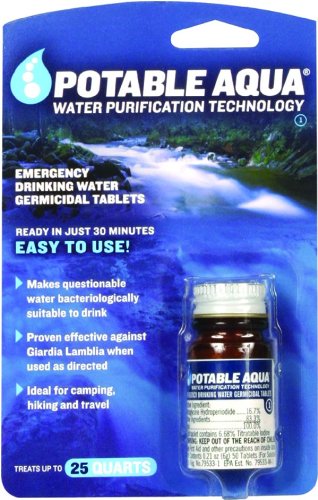








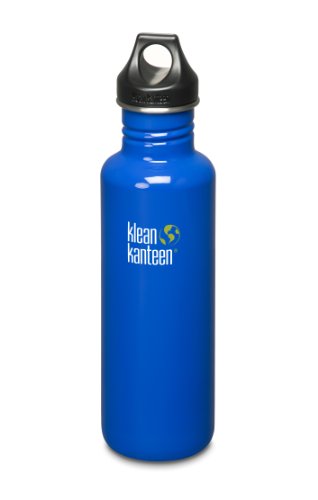
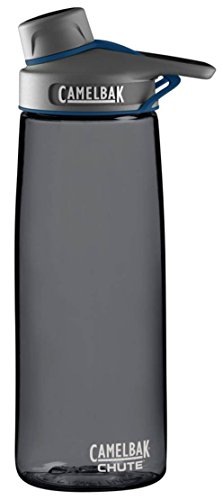
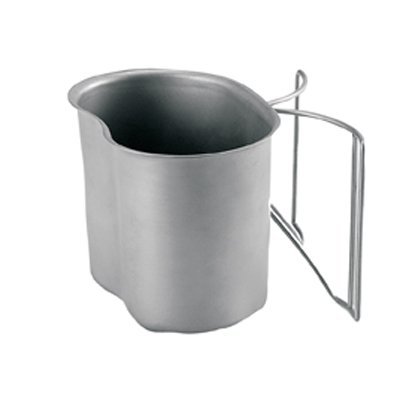




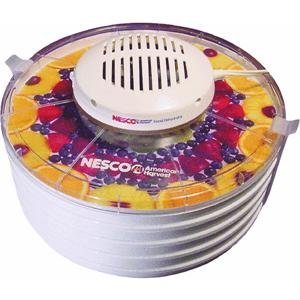



Comparing chemical treatment methods,
The EPA estimates that 90{660353129f8d892044c993645a1c75194301fec6786a7f617c15adde0b0011e9} of the world’s fresh water is contaminated and unsuitable for drinking. The days of kneeling down on a hike and sipping from the stream are long gone. Don’t make the mistake of thinking that just because water looks clear or tastes good that it is free of contaminants. That includes frozen water, which can house hepatitis A, Salmonella, and Cryptosporidium for months.
There are many options for purifying the water, but this post will compare commercial products that rely on halogen chemical treatments.
Polar Pure – contains iodine crystals, has an almost indefinite shelf life if kept tightly sealed, and very inexpensive per dose cost, requires measuring the dosage using the cap (which can be imprecise).
Potable Aqua – contains iodine tablets, shelf life of up to four years if properly stored – if they’ve turned a light green don’t use, moderately expensive per dose cost, easy to administer doses (two tablets per quart of water).
Micropur MP1 – contains chlorine dioxide tablets, has a shelf life of at least five years, moderately expensive per dose cost, and comes in easy to administer doses (one tablet per quart of water).
Simple household bleach – 2 drops per quart of water (assuming a a bleach solution of 5-6{660353129f8d892044c993645a1c75194301fec6786a7f617c15adde0b0011e9} hypochlorite), may wish to double the dose for cloudy water, shelf life of bleach is only about 6 months, must use a dropper to administer dose, very inexpensive per dose cost.
Tincture of iodine – 5 drops per quart (assuming a 2{660353129f8d892044c993645a1c75194301fec6786a7f617c15adde0b0011e9} iodine solution), may wish to double the dose for cloudy water, almost indefinite shelf life if properly stored, must use a dropper to administer dose, modest per dose cost.
All of the methods are effective at killing bacteria, somewhat effective against viruses, and of limited value against protozoa cysts. Cryptosporidium in particular is resistant to halogen treatments.
Most treatments only require 30 minutes. However, very cold water (i.e., less than 40 degrees F) should be allowed to sit for 2 or more hours, or be treated with a double dose.
As far as taste, all will introduce some chemical taste into the water. In a very unscientific taste test of chemical treatment methods, my own family concluded that iodine-treated water was by far the worst smelling and tasting, bleach-treated was second, and water treated with Micropur MP1 ready-to-use tablets was the least objectionable.
Finally, you can add Kool-aid to treated water to help the taste. Not only will it help to mask the chemical taste, but the ascorbic acid (vitamin C) converts the chlorine or iodine to tasteless chloride and iodide.
Written by Arthur Bradley, author of “Handbook to Practical Disaster Preparedness for the Family.”
Please be kind enough to indicate if reviews are helpful.
Was this review helpful to you?

|All good backpackers have these, but as the label states they are for “emergency use”,
The 5 most common ways backpackers/campers purify water are
1. Boil it. Obviously slow and cumbersome. If doing strenuous backpacking/canoeing each person will need to boil a big pot of water every night.
2. Natural sunlight – letting water sit in the sun for 6 hours works (need cloudless day, correct kind of clear plastic container). The World Health Organization published a study on this, but Amazon won’t let me link to it.
3. Water pump – I have used MSR HyperFlow Microfilter, though there are cheaper options if you can accept it being slightly larger. In my opinion this is the best method.
4. Household chlorine bleach – the EPA and WHO give instructions on doing this. The EPA says this may not kill Cryptosporidium. I’ve never tried.
5. Iodine tablets (or other chemical treatments)-
Positives:
-Tablets are small/light for backpackers
-Only takes 30 minutes to have water ready
-No work required
Negatives:
-EPA says it is not 100{660353129f8d892044c993645a1c75194301fec6786a7f617c15adde0b0011e9} affective against Giardia and Cryptosporidium, especially if the water is cold while being treated.
-The taste is slightly bad (‘metallic’ is my best description).
I think a good attitude towards these tablets is “emergency use” (which is labeled on the side of the bottle, not visible in the Amazon image). No good backpacker doesn’t have these, but I suggest a water pump as the planned primary method. Note: there are also iodine “neutralizer” tablets that are supposed to remove the bad taste (you drop them in after the 30 minutes is up and wait another 30 minutes). In my opinion they barely change the taste and are not worth it.
I’m only giving 4 stars since the EPA says it is not 100{660353129f8d892044c993645a1c75194301fec6786a7f617c15adde0b0011e9} effective against Giardia and Cryptosporidium. I’d give 5 stars if the product was named something like “EMERGENCY AQUA” instead of “POTABLE AQUA”.
Was this review helpful to you?

|Does Its Job,
These do what they’re supposed to do. Before I give a review, I’ll quote the box on a few points.
1. For use only when drinking water is suspected or known to be bacteriologically substandard. Not to be used on a continuous basis. (Their website suggests a six-week limit.)
2. Unopened bottles should remain effective for four years. (Look at the bottom of this review for how to date your tablets.)
3. We recommend that you do not keep an opened bottle for more than one year.
4. 2 tablets make one quart of bacteriologically water suitable to drink.
5. Proven effective against Giarda Lamblia when used as directed.
6. Has not been shown to inactivate Cryptosporidium cysts.
In a nutshell, use according to the directions and you’ll be just fine. The bottle contains 50 tablets; you use two per quart of water. In really murky water, I use three. The active ingredient is Tetraglycine Hydroperiodide 16.7{660353129f8d892044c993645a1c75194301fec6786a7f617c15adde0b0011e9} and each tablet contains 6.68{660353129f8d892044c993645a1c75194301fec6786a7f617c15adde0b0011e9} of Titratable Iodine. This is the same stuff that I used in the military, but just to be sure, I opened a bottle and got three quarts of water from the Ohio River. Murky stuff. The first quart was treated with just the Potable Aqua (2-1/2 tablets). The second quart was boiled for ten minutes. The third quart was boiled for ten minutes, then given two tablets of Potable Aqua. All water was filtered through an untreated handkerchief first to remove debris and sediment. I’ll note that my measurements were three quarts before boiling, so I’m sure some of the water was lost in the last two quarts due to the boiling process. The results?
While none of the water was as good as tap water, I’m still alive. The first batch (just Potable Aqua) was okay. I remember Potable Aqua having a bad taste; so bad that they included a separate bottle of pills to add that made the taste more bearable. That other bottle is unnecessary here. The water definitely had a chemical taste, but I could drink the minimum of a gallon a day if I needed to.
The second batch (just boiling, no pills) tasted better, but smelled bad. I would be hesitant to drink any more than necessary.
The third batch (boiled, then treated with Potable Aqua) was obviously the best. Considering that boiling only took ten minutes and a metal water bottle, this is the best option. Remember that all of the water was filtered through a handkerchief first to get rid of any sediment, debris, bugs, etc.
I’ll guess that if you filter the water, then boil, then use the tablets, you can use only one tablet. I’m not a doctor, dietician, or representative of the company, but I do have extensive training in SERE operations and I’ve been using these tablets for over fifteen years.
How can you find out when your pills were made? Each bottle has a series of numbers imprinted. For example: 403127. The first number is the month; in this case, the fourth month is April. The second and third numbers are the last two of the year; in this case, 2003. These pills were made in April of 2003. The last three numbers (127) indicate that this was the 127th batch made in that time frame. The code can be five or six numbers long; the first three numbers always denote the month and year; the last two or three always denote the batch number.
Was this review helpful to you?

|